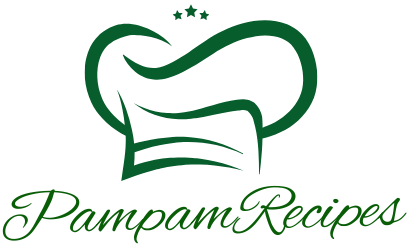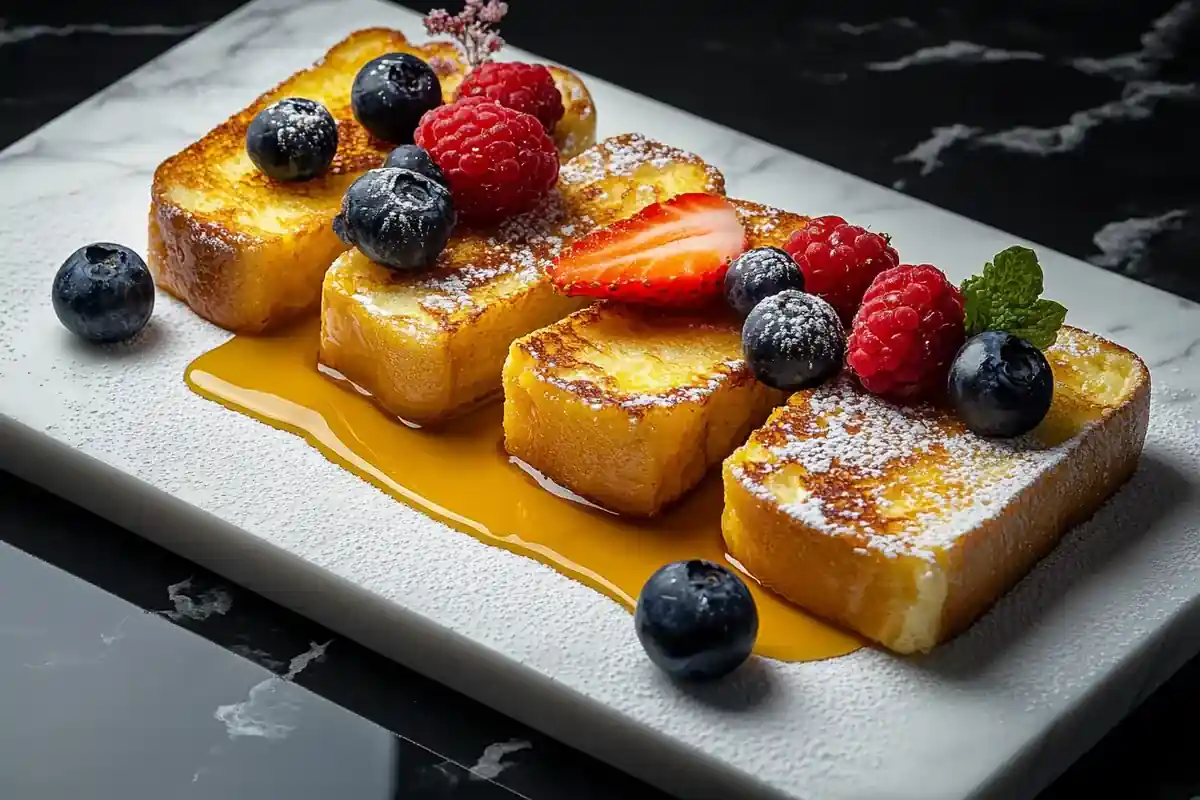introduction
French toast is a beloved breakfast dish, but it’s easy to get wrong. If you’ve ever asked yourself, “What is the most common mistake in making French toast?”, you’re not alone. From soggy bread to burnt edges, small missteps can ruin an otherwise simple recipe. In this guide, we’ll explore the most frequent errors and provide practical tips to help you master perfect French toast every time.
In this article, we’ll explore the most common errors people make when preparing French toast and how to fix them. From choosing the wrong bread to over-soaking, we’ll address these challenges step by step. You’ll also learn the secrets to crafting flawless French toast, with a foolproof recipe and practical tips to ensure every slice turns out perfect.
Common Mistakes in Making French Toast
Over-Soaking the Bread
One of the biggest pitfalls in making French toast is over-soaking the bread. While soaking is essential for absorbing the custard, leaving the bread submerged for too long can cause it to fall apart or become soggy when cooked. This happens because overly wet bread struggles to hold its shape during frying.
To avoid this mistake, aim for a soaking time of about 20–30 seconds per side, depending on the bread’s thickness and density. For thin or delicate bread, a quick dip is usually sufficient. Always allow the excess custard to drip off before placing the bread in the pan.
Using the Wrong Bread
Another common mistake is using the wrong type of bread. Soft, pre-sliced sandwich bread may seem convenient, but it often leads to French toast that is too flimsy or soggy. Instead, opt for sturdy, slightly stale bread like brioche, challah, or a French baguette. These breads have the perfect texture for soaking up custard without falling apart.
Additionally, thicker slices—about 3/4 to 1 inch—work best. They allow the custard to penetrate without making the bread mushy. If your bread is fresh, lightly toast it beforehand to mimic the texture of day-old bread.
By avoiding these two common mistakes, you’ll set yourself up for success and create French toast that’s both flavorful and structurally sound.
Essential Ingredients for Perfect French Toast
Creating the perfect French toast starts with the right ingredients. If you’ve ever wondered, “What is the most common mistake in making French toast?”, it often begins with selecting the wrong components. Here’s a breakdown of what you’ll need to make French toast that’s flavorful, rich, and perfectly textured.
The Role of Milk and Eggs
Milk and eggs form the custard base that gives French toast its signature creamy interior. However, the balance between these two ingredients is crucial. Using too much milk can result in soggy bread, while too many eggs can make the toast taste overly dense and eggy. A typical ratio of 1/2 cup milk to 2 large eggs works well for every 4 slices of bread.
Choose whole milk for its richness, or substitute with plant-based alternatives like almond or oat milk for a dairy-free version. Additionally, whisking the milk and eggs thoroughly ensures a smooth, uniform custard.
Choosing the Right Spices and Sweeteners
Spices and sweeteners add depth and complexity to the flavor of French toast. A classic combination includes:
- Vanilla Extract: Adds a warm, aromatic note.
- Cinnamon: Provides a subtle spice that complements the sweetness.
- Sugar: A tablespoon or two in the custard enhances the flavor without being overpowering.
For extra flair, consider adding a pinch of nutmeg or a drizzle of maple syrup directly into the mixture. These small additions can make a big difference in taste.
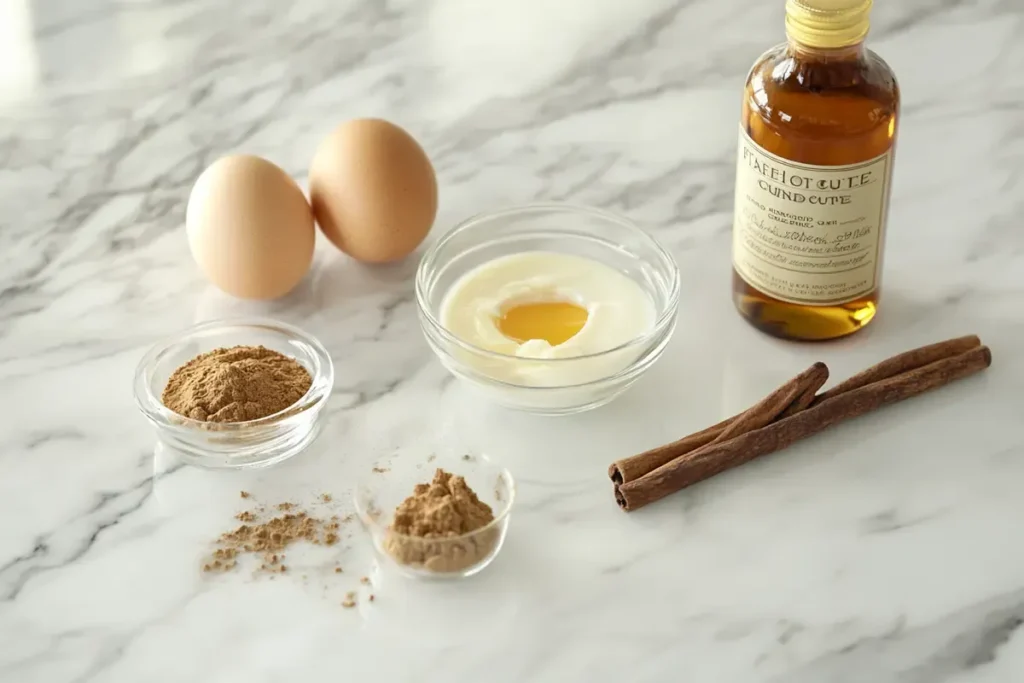
Step-by-Step Recipe for Perfect French Toast
Now that you have the ingredients ready, let’s dive into a foolproof recipe. Follow these steps to ensure your French toast is golden, crisp, and delicious every time.
Ingredients List
- 4 slices of slightly stale bread (brioche, challah, or sourdough recommended)
- 2 large eggs
- 1/2 cup whole milk (or non-dairy alternative)
- 1 tablespoon sugar
- 1/2 teaspoon cinnamon
- 1 teaspoon vanilla extract
- 1 tablespoon butter (for cooking)
Preparation Instructions
- Prepare the Custard
- In a medium bowl, whisk together the eggs, milk, sugar, cinnamon, and vanilla extract. Whisk until the mixture is smooth and well-combined.
- Prep the Bread
- If using fresh bread, lightly toast it to mimic the texture of day-old bread. This helps prevent sogginess when soaked in custard.
- Heat the Pan
- Preheat a nonstick skillet or griddle over medium heat. Add a small amount of butter, allowing it to melt and coat the surface evenly.
Cooking Instructions
- Soak the Bread
- Dip each slice of bread into the custard mixture, letting it soak for about 20–30 seconds per side. Be sure to allow any excess custard to drip off before placing the bread in the pan.
- Cook the Toast
- Place the soaked bread onto the heated skillet. Cook for 2–3 minutes per side, or until golden brown and slightly crisp on the edges. Adjust the heat as needed to prevent burning.
- Serve and Enjoy
- Remove the toast from the skillet and serve immediately with your favorite toppings.
Optional Toppings and Variations
Enhance your French toast with these delicious toppings:
- Fresh fruits like strawberries, blueberries, or banana slices.
- A drizzle of maple syrup, honey, or chocolate sauce.
- Whipped cream or powdered sugar for an elegant touch.
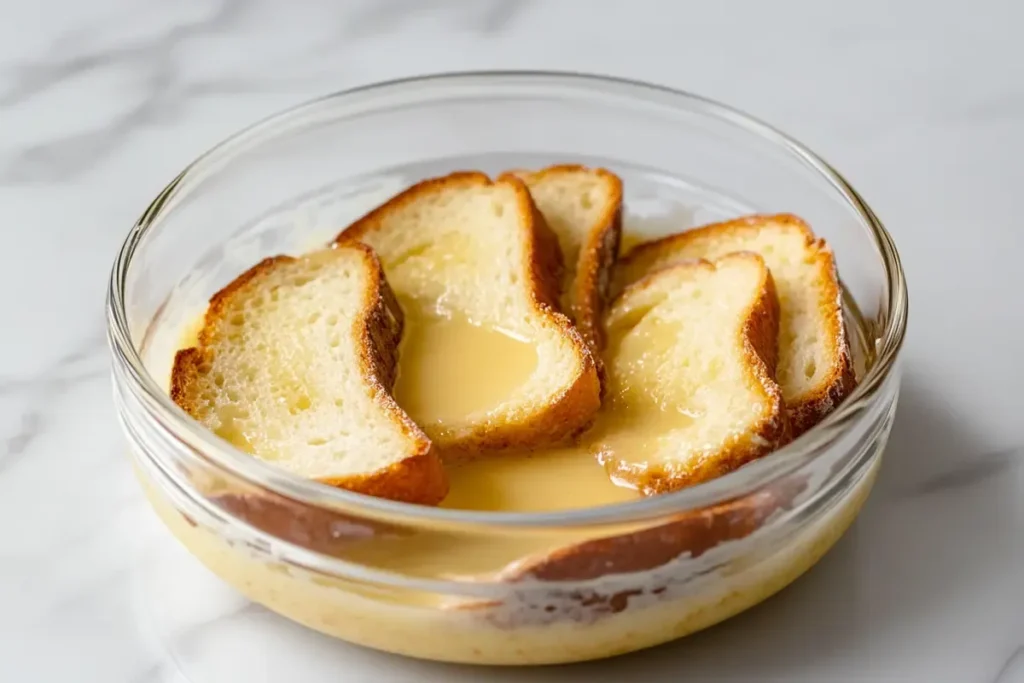
Nutritional Content (Per 100g)
| Nutrient | Value |
|---|---|
| Calories | 210 |
| Carbohydrates | 24g |
| Protein | 8g |
| Fat | 8g |
| Fiber | 1g |
| Sodium | 310mg |
For more tips and tricks, explore our related article on how to master French toast variations.
Tips for Making the Best French Toast
Perfecting French toast requires attention to detail and a few insider tricks. If you’ve ever asked yourself, “What is the most common mistake in making French toast?”, you’re not alone. Here’s how to avoid those pitfalls and elevate your cooking skills.
Balancing Heat and Cooking Time
One frequent mistake is cooking French toast on heat that’s too high. While high heat might speed up the process, it often results in burnt exteriors and undercooked centers. To ensure even cooking, use medium heat and allow the bread to cook slowly.
Start by preheating your pan for about a minute. Then, add butter and let it melt evenly before placing the soaked bread in the pan. Cook each side for 2–3 minutes, adjusting the heat as needed to achieve a golden brown crust.
Prepping the Pan Properly
Another overlooked detail is preparing the pan. A nonstick skillet or griddle works best, as it prevents sticking and promotes even browning. Butter is the traditional choice for greasing the pan, but you can also use a neutral oil or a combination of the two. Be sure to spread it evenly across the surface to avoid uneven cooking.
These tips will help you master the texture and flavor of your French toast while avoiding the most common mistakes.
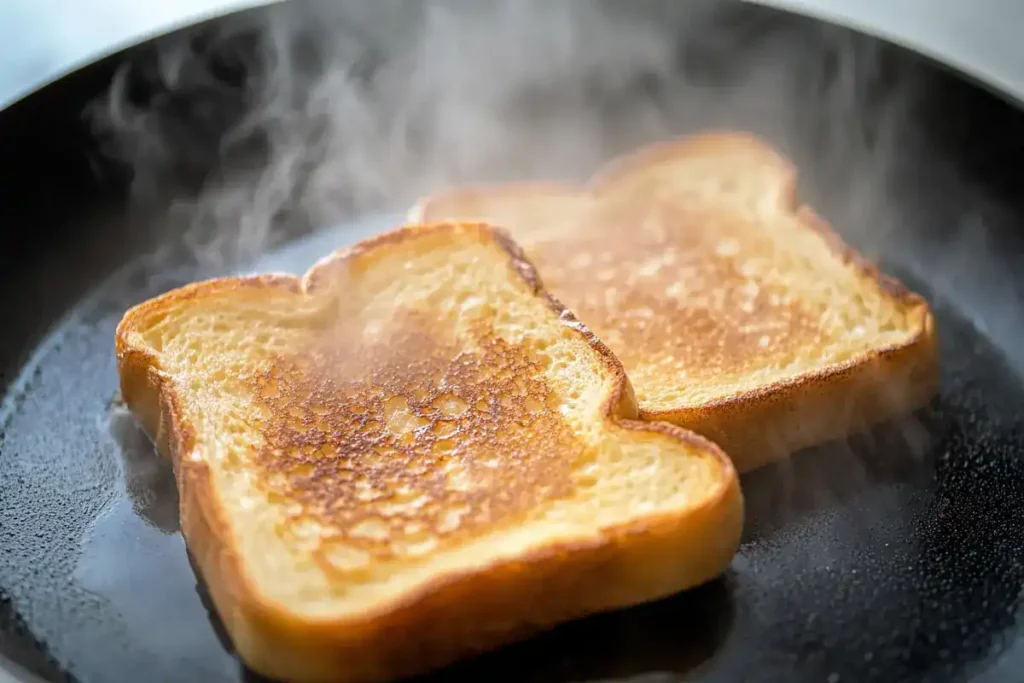
FAQs About French Toast
French toast is simple to make, but small details can lead to big differences in the final result. Below, we answer common questions like “What is the most common mistake in making French toast?” to help you refine your technique.
What Is the Trick to Not Soggy French Toast?
The key to avoiding soggy French toast lies in the bread and custard. Use slightly stale bread, which is firmer and less likely to absorb excess liquid. Additionally, ensure your custard has the right balance of milk and eggs—about 1/4 cup milk per egg works well.
How Long Should French Toast Soak?
The soaking time depends on the bread’s thickness and density. As a general rule, soak each slice for 20–30 seconds per side. For thicker or denser breads like challah or brioche, a longer soak may be needed to ensure the custard penetrates the center.
Why Doesn’t My French Toast Get Crispy?
Crispiness comes down to heat and fat. Cook the toast on medium heat, and make sure the pan is properly greased with butter or oil. Avoid overcrowding the pan, as this can create steam and prevent a crisp exterior.
What Is the Key to Good French Toast?
Good French toast combines the right ingredients, proper technique, and attention to detail. Choose high-quality bread, use fresh spices, and cook at a steady temperature for consistent results.
For more breakfast inspiration, check out this cinnamon roll French toast recipe, which adds a creative twist to the classic dish.
French Toast Variations and Additions
French toast is a versatile dish that can be customized to suit any taste. If you’ve mastered the basics and are curious about expanding your options, here are some creative ideas. These variations ensure that French toast never feels repetitive while allowing you to avoid “What is the most common mistake in making French toast?” by adapting to different preferences.
Savory French Toast Options
While French toast is traditionally sweet, savory versions are gaining popularity. To create a savory twist, omit the sugar and cinnamon from your custard mixture. Instead, add:
- A pinch of salt and pepper.
- Grated Parmesan or cheddar cheese for a cheesy crust.
- Fresh herbs like parsley or chives for added flavor.
Serve savory French toast with toppings such as avocado slices, sautéed mushrooms, or a fried egg for a hearty meal.
International Twists on French Toast
French toast has inspired dishes around the world, each with its unique flair. Try these global variations:
- Pain Perdu: A French version that uses stale bread soaked in custard, often served with powdered sugar.
- Torrijas: A Spanish twist soaked in sweetened milk and often fried in olive oil.
- Hong Kong-Style French Toast: Layers of bread stuffed with peanut butter or custard, deep-fried, and drizzled with syrup.
Exploring these variations can help you discover new flavors while showcasing the dish’s universal appeal.
Storing and Reheating French Toast
If you’ve made a batch of French toast and have leftovers, proper storage and reheating are essential to maintaining its flavor and texture. Avoiding common mistakes in this process ensures your toast stays fresh and delicious.
Best Practices for Storage
To store French toast effectively:
- Allow the slices to cool completely at room temperature.
- Place them in an airtight container or wrap them tightly in plastic wrap.
- Store in the refrigerator for up to 3 days or freeze for up to 3 months.
Label your container with the date to keep track of freshness. If freezing, separate each slice with parchment paper to prevent sticking.
Reheating Tips for Fresh Taste
Reheating French toast is simple, but choosing the right method is important to avoid a soggy texture:
- Oven Method: Preheat your oven to 350°F (175°C). Place the toast on a baking sheet and heat for 5–8 minutes, flipping halfway through.
- Stovetop Method: Heat a nonstick skillet over medium heat. Add a small amount of butter and reheat each slice for 1–2 minutes per side.
- Microwave Method: Place a slice on a microwave-safe plate and cover with a damp paper towel. Heat in 20-second intervals until warm.
With these storage and reheating tips, your French toast will taste just as delicious the second time around. For additional breakfast ideas, explore more creative recipes on PamPam Recipes.
Why French Toast Is a Breakfast Staple
French toast has earned its place as a breakfast favorite worldwide. It’s versatile, easy to make, and endlessly customizable. Yet, even with its simplicity, many home cooks ask, “What is the most common mistake in making French toast?” Mastering this dish ensures it remains a go-to for any morning meal.
Combines Comfort and Elegance
One of the best things about French toast is its ability to bridge comfort and sophistication. On one hand, it’s a simple way to use up stale bread, and on the other, it can be transformed into a gourmet dish with high-end toppings like mascarpone or fresh berries. This adaptability makes French toast a favorite for both casual breakfasts and special occasions.
Perfect for Any Occasion
French toast isn’t just for breakfast. Its flexibility allows it to shine at brunch, as a dessert, or even as a quick snack. Plus, you can easily scale the recipe to serve a crowd or enjoy it solo. Whether it’s a weekday breakfast or a celebratory brunch, French toast fits seamlessly into any menu.
Final Thoughts
Now that you’ve learned the key to avoiding common pitfalls like soggy bread or burnt edges, you’re ready to make French toast like a pro. By focusing on the right ingredients, techniques, and creative variations, you can avoid asking yourself, “What is the most common mistake in making French toast?” ever again.
Recap of Key Tips
Here are the main takeaways to ensure success:
- Use slightly stale, sturdy bread for the best texture.
- Balance your custard ingredients with the right ratio of milk to eggs.
- Soak the bread just long enough to absorb flavor without becoming soggy.
- Cook on medium heat and prep the pan properly to avoid sticking or burning.
Keep Exploring and Experimenting
French toast is a dish that thrives on experimentation. Once you’ve mastered the basics, try different bread types, spices, and toppings to keep things exciting. For more breakfast ideas and tips, explore recipes on PamPam Recipes, where inspiration is just a click away.
With these tips and tricks in hand, your French toast will always turn out golden, crisp, and delicious—a true breakfast masterpiece!
